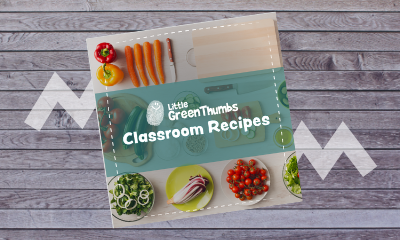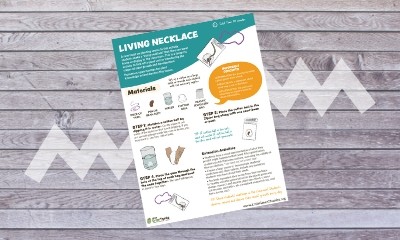
Check out the simple, practical dishes that you can prepare in the classroom with your students. What are you waiting for? Let’s get cooking!
We asked our Little Green Thumbs teachers for their tried and tested garden-inspired recipes and they sent us their favourites.
After a growing season with your students, there is no better way to enjoy the harvest than to prepare a meal or snack together with your fresh garden vegetables. Many students have already heard the saying ‘you are what you eat’, and it’s pretty true!
Fueling up on healthy nutritious snacks gives us the energy, strength and drive to complete challenging tasks and learning. Cooking with students is a fantastic way to build kitchen confidence and positive relationships with healthy foods.
Outcomes
3.0 Example of curricular outcome

A new twist on planting seeds! In this activity, students make a “living necklace” that they can wear home or display in the classroom. This is a fantastic activity to kick off a plant unit or introducing the stages of plant growth and development. Includes a student hand out to predict what will happen to the seed over the course of a few days.
Numerous opportunities for plant knowledge extend beyond this lesson.

Nature presents an incredible visual rainbow. For centuries, people have captured these natural hues for decorating animal skins, fabrics, crafts, hair, and bodies. Dyeing with plants can provide an intriguing lens for exploring the local environment, learning science concepts, conducting experiments, learning about history and other cultures, and creating compelling crafts.
Students will investigate the use of plants to create natural dyes, experimenting with different dyeingmethods and a variety of plant materials.
Background: Since prehistoric times, humans from across the globe have used plant pigments to enrich their lives. Historians and scientists believe that prehistoric animal skins and cave paintings dating back to 15,000 B.C. were dyed with plant pigments. They’ve discovered examples of early dyed fibers in Egypt dating to around 2000 B.C., and Chinese records revealing even earlier use of plants as fabric dyes. Ancient Britons, called Picts, used a plant called woad to dye their bodies blue and frighten enemies in battle, while the British “red coats” who marched against the Ameri- cans in Revolutionary War times wore uniforms colored with dye made from the roots of the madder plant.
Most plant parts have a mixture of pigments, which is why dyes made from plants tend to appear more subtle and muted—less “pure”—than the synthetic dyes that are now used to color our world. However, the “earth tones” of plant dyes continue to intrigue many hobby and craft dyers because the rich hues of Mother Nature all seem to “go together.”

Plant pigments are colorful molecules found within plant cells. Explore with your students!
You will prepare watercolour vegetable ‘paints’ with your students. Each vegetable or fruit will give you a different color: spinach is green, beets and raspberries are red, golden beets are yellow, and blackberries are a dark purple.




